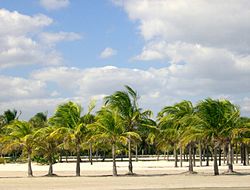Fauna
Environmental issues
The beaches of Key Biscayne in Miami.
Main article: Environment of Florida
Florida is a low per capita energy user.[71] It is estimated that approximately 4% of energy in the state is generated through renewable resources.[72]
Florida's energy production is 6% of the nation's total energy output,
while total production of pollutants is lower, with figures of 5.6% for nitrogen oxide, 5.1% for carbon dioxide, and 3.5% for sulfur dioxide.[72]All potable water resources have been controlled by the state government through five regional water authorities since 1972.[73]
Red tide has been an issue on the southwest coast of Florida, as well as other areas. While there has been a great deal of conjecture over the cause of the toxic algae bloom, there is no evidence that it is being caused by pollution or that there has been an increase in the duration or frequency of red tides.[74]
The Florida panther is close to extinction. A record 23 were killed in 2009 predominately by automobile collisions, leaving about 100 individuals in the wild. The Center for Biological Diversity and others have therefore called for a special protected area for the panther to be established.[75] Manatees are also dying at a rate higher than their reproduction.
Much of Florida has an elevation of less than 12 feet (3.7 m), including many populated areas. Therefore, it is susceptible to rising sea levels associated with global warming.[76] The Atlantic beaches that are vital to the state's economy are being washed out to sea due to rising sea levels caused by climate change. The Miami beach area, close to the continental shelf, is running out of accessible offshore sand reserves.[77]

No comments:
Post a Comment